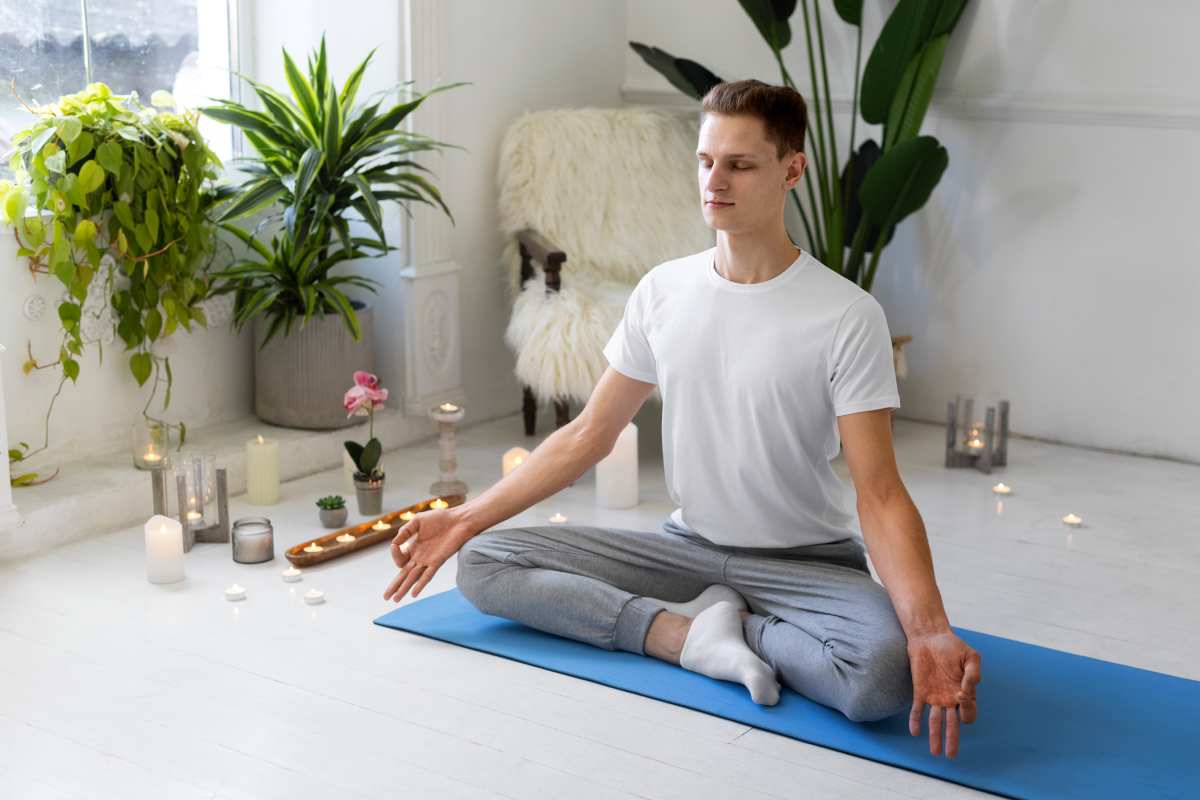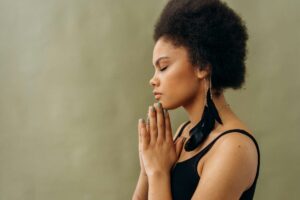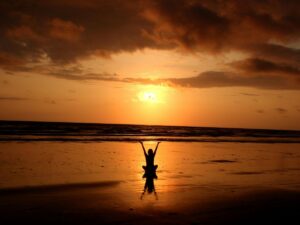Stepping onto a yoga mat for the first time can feel both exciting and intimidating. Perhaps you’ve watched elegant yoga practitioners twist into impossible-looking shapes or heard friends talk about how yoga changed their lives. Maybe you’re simply looking for a gentle way to move your body or find some calm in your busy life. Whatever brings you here, know this: yoga truly is for everyone, and beginning your practice doesn’t need to be complicated.
As someone who stumbled into their first yoga class with tight hamstrings and zero balance skills, I can tell you that where you start doesn’t determine where you’ll end up. This guide will walk you through everything you need to know to begin yoga with confidence, comfort, and curiosity.
Understanding Yoga Basics
Yoga is much more than the physical poses (asanas) you might see on Instagram. At its core, yoga is an ancient practice that combines physical movement, breathing techniques, and mindfulness to create harmony between body and mind.
What Yoga Truly Is
Originating in India over 5,000 years ago, yoga was developed as a comprehensive practice for well-being on all levels. The word “yoga” comes from Sanskrit and means to join or unite, representing the connection between body, mind, and spirit.
While modern Western yoga often emphasizes the physical aspects, traditional yoga includes:
- Physical postures (asanas)
- Breathing exercises (pranayama)
- Meditation and mindfulness
- Ethical guidelines for living
- Self-discipline practices
Common Misconceptions About Yoga
Before diving deeper, let’s clear up some misunderstandings:
- “You must be flexible to do yoga” – This is like saying you need to be clean to take a shower. Flexibility is a potential result of yoga, not a prerequisite.
- “Yoga is just stretching” – While stretching is involved, yoga also builds strength, balance, and body awareness.
- “Yoga is only for young, thin women” – Yoga is for every body, regardless of age, size, gender, or physical ability.
- “Yoga is a religion” – While yoga originated within Indian spiritual traditions, the practice itself is not tied to any particular religious belief.
Different Styles of Yoga
Like choosing a restaurant, finding the right yoga style depends on your taste and what you’re looking for:
- Hatha: A gentle introduction focusing on basic postures and breathing. Perfect for beginners.
- Vinyasa: Flowing movements synchronized with breath. More active and varied.
- Yin: Passive poses held for longer periods, targeting deep connective tissues. Great for flexibility and stress relief.
- Restorative: Uses props to fully support the body in relaxing poses. Excellent for recovery and relaxation.
- Ashtanga: A structured, vigorous sequence of poses. Challenging but rewarding.
- Kundalini: Combines movement, breathing, meditation, and chanting. More spiritually focused.
As a beginner, Hatha, gentle Vinyasa, or Restorative classes are typically most accessible.
Getting Started: Essential Preparations
Starting yoga doesn’t require expensive equipment or special skills. With a few basics and the right mindset, you’ll be ready to begin.
Setting Realistic Expectations
Yoga is a personal journey, not a competition:
- Your practice will look different from others, and that’s perfect
- Progress happens gradually and often in unexpected ways
- The goal isn’t to achieve perfect poses but to be present in your body
- Some days will feel better than others, and that’s normal
Basic Equipment You’ll Need
The beauty of yoga is its simplicity. Here’s what you actually need:
- A yoga mat: Provides cushioning and grip. A basic mat ($15-30) is fine to start.
- Comfortable clothes: Anything you can move in freely. No special “yoga clothes” required.
- Water bottle: Stay hydrated before, during, and after practice.
Optional items that can be helpful:
- Yoga blocks: Provide support and stability in poses
- Yoga strap: Helps extend your reach in certain poses
- Blanket: Offers cushioning for joints or warmth during relaxation
Creating a Comfortable Practice Space
Your yoga space doesn’t need to be fancy, just functional:
- Find a quiet area where you won’t be disturbed
- Ensure you have enough room to extend your arms and legs fully
- Check that the floor is relatively flat and clean
- Consider temperature—being too hot or cold can be distracting
- Minimize distractions—silence your phone and let others know you need some time
Your First Yoga Practice
Your first yoga experience should be gentle and exploratory. Remember, you’re learning a new language of movement.
Simple Poses to Begin With
These foundational poses build body awareness and prepare you for more complex movements:
- Mountain Pose (Tadasana): Standing tall with feet together, arms at sides. Seems simple but teaches proper alignment.
- Child’s Pose (Balasana): Kneeling with forehead to mat, arms extended or by sides. A resting pose you can return to anytime.
- Cat-Cow Stretch: On hands and knees, alternating between arching and rounding your back. Great for spinal mobility.
- Downward-Facing Dog: Creates an inverted V-shape with your body. A fundamental pose that stretches and strengthens.
- Warrior I: A standing pose that builds strength and stability in the legs.
- Seated Forward Fold: Sitting with legs extended, folding forward from the hips. Releases tension in the back body.
- Corpse Pose (Savasana): Lying flat on your back, completely relaxed. Typically practiced at the end of a session.
Proper Breathing Techniques
Breath is the foundation of yoga practice:
- Basic yogic breathing involves breathing deeply through the nose
- Try to match the length of your inhale and exhale
- Use your breath as an anchor when your mind wanders
- In many traditions, movement follows breath—inhale to extend, exhale to fold
How to Modify Poses for Your Body
Every body is different, and poses should be adjusted accordingly:
- Use yoga blocks to “bring the floor closer” in forward folds or standing poses
- Bend your knees generously in forward bends to protect your back
- Rest your knees on the floor during planks if needed
- Use a wall for balance in standing poses
- Remember: the “best” version of a pose is the one that works for YOUR body
Finding the Right Teacher or Class
The right guidance can make a tremendous difference in your yoga journey.
In-Person vs. Online Options
Both approaches have their benefits:
In-person classes:
- Provide immediate feedback and adjustments
- Create community and accountability
- Allow the teacher to see and correct your form
- Offer a dedicated space for practice
Online classes:
- Provide flexibility with timing and location
- Often cost less than studio classes
- Allow you to learn at your own pace
- Let you practice without feeling self-conscious
Many practitioners use a combination of both approaches.
What to Look for in a Yoga Instructor
A good teacher can inspire your practice for years to come:
- Proper training and certification (look for RYT – Registered Yoga Teacher)
- Clear, accessible instruction style
- Offers modifications for different bodies and abilities
- Creates a welcoming, non-judgmental atmosphere
- Emphasizes safety and proper alignment
- Respects students’ boundaries
Questions to Ask Before Joining a Class
Before committing to a class or teacher:
- Is this class appropriate for beginners?
- Will modifications be offered?
- What style of yoga is taught?
- What should I bring?
- How large is the class?
- Is pre-registration required?
Most studios offer introductory specials for new students, which can be a great way to try different classes.
Developing a Sustainable Practice
Consistency matters more than intensity when beginning yoga.
Creating a Manageable Schedule
Set yourself up for success with realistic planning:
- Start with shorter sessions (10-30 minutes) rather than jumping into 90-minute classes
- Choose 2-3 specific days per week for practice
- Schedule yoga sessions in your calendar like any other important appointment
- Pair yoga with existing habits to build consistency (morning coffee, then yoga)
- Be flexible with yourself—a missed practice isn’t a failure
How Often to Practice as a Beginner
Quality trumps quantity, especially at first:
- 2-3 times per week is excellent for beginners
- Daily practice can be beneficial but keep sessions shorter (10-15 minutes)
- Include a mix of more active and more restorative practices
- One longer class plus several shorter home practices is a balanced approach
Listening to Your Body and Knowing Your Limits
Developing body awareness is a key benefit of yoga:
- Distinguish between productive discomfort and potential injury
- Back off when something causes sharp pain or pinching sensations
- Notice which poses energize you and which help you relax
- Track how your body feels after practice—increased mobility? Better sleep?
- Adjust your practice based on energy levels, stress, and physical condition
Common Challenges and How to Overcome Them
Every yoga beginner faces obstacles. Here’s how to work through them:
Dealing with Initial Stiffness
Feeling tight is normal and temporary:
- Focus on consistency rather than depth in poses
- Use props generously to support your body
- Try gentle warm-up movements before deeper stretches
- Practice after a warm shower when muscles are more pliable
- Remember that flexibility develops slowly—be patient with your body
Staying Motivated When Progress Seems Slow
Yoga benefits accumulate subtly:
- Keep a simple journal noting how you feel after each practice
- Take photos (for your eyes only) to track physical progress
- Celebrate non-physical victories like better sleep or stress management
- Follow yogis with similar body types or limitations for inspiration
- Set process goals (“practice twice weekly”) rather than achievement goals (“touch toes by June”)
Handling Self-Consciousness
Everyone feels awkward sometimes:
- Remember that most people are focused on their own practice, not watching you
- Position your mat in a comfortable spot (not front center if you’re feeling shy)
- Close your eyes during challenging moments to center yourself
- Remind yourself why you started yoga
- Consider that your presence makes other beginners feel welcome too
Beyond the Mat: Integrating Yoga into Daily Life
The most powerful yoga happens off the mat, in your everyday experiences.
Mindfulness Practices
Yoga principles can enhance daily awareness:
- Take three conscious breaths before responding in tense situations
- Notice physical sensations during routine activities like eating or walking
- Practice gratitude for your body’s abilities, whatever they may be
- Observe thoughts without judgment, just as you would in meditation
Simple Stretches for Work Breaks
Mini-practices keep you flexible throughout the day:
- Seated side bends and gentle twists at your desk
- Shoulder rolls and neck stretches between tasks
- Forward fold while waiting for the kettle to boil
- Gentle backbends after long periods of sitting
How Yoga Principles Apply to Everyday Situations
Yoga philosophy offers wisdom for modern life:
- Practice ahimsa (non-harm) through kind self-talk and compassion for others
- Apply santosha (contentment) by appreciating what you have
- Use pranayama (breath control) to manage anxiety in challenging moments
- Remember that balance isn’t about perfection—it’s about adjustment and response
Final Thoughts
Beginning yoga is like planting a garden—the initial preparation may seem like a lot of work for little visible result, but with consistent attention, something beautiful will grow. Your practice will evolve as you do, offering different benefits throughout your life.
Remember that every experienced yogi was once a beginner, uncertain and wobbly. The only “perfect” yoga practice is the one that serves you in this moment, in this body, with its unique needs and capabilities.
The mat is waiting for you—just as you are, right now. Take that first step, and begin.
What part of beginning yoga are you most curious or concerned about? Share in the comments below, and let’s support each other’s journeys.




